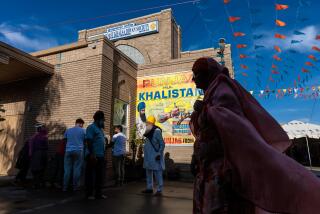India Still Torn by Sikh Violence in Wake of ‘Trial of Century’
- Share via
NEW DELHI — Indian Supreme Court Justice K. Jagannath Shetty spent his two-month vacation reliving the assassination of Prime Minister Indira Gandhi.
At his home in the south Indian city of Bangalore, Shetty read at least twice the 4-foot-high stack of proceedings from the trial of the surviving assassin and two accused accomplices in the killing of Gandhi on Oct. 31, 1984.
The judge went further. He pored over trial notes from the century-old case, U.S. vs. John Wilkes Booth, because, as Shetty told an American, “Through history, there is only one parallel to this case in the world--the assassination of your President Abraham Lincoln.”
Only then, Shetty said, was he ready to make history.
Last month, Shetty and two other Supreme Court judges ended India’s “trial of the century” by condemning the assassin and an accomplice to death. The second accused accomplice was acquitted.
“Our decision demanded this sort of care,” the justice explained, “because this is perhaps the most sensitive matter in our nation today.”
Escalating Sikh Holy War
Indeed, the landmark decision came against the backdrop of an escalating Sikh holy war that inspired two of Gandhi’s Sikh bodyguards, one of them Satwant Singh, who is now on Death Row, to shoot her at least 25 times as revenge for ordering commandos to invade the Golden Temple in Amritsar, Sikhdom’s holiest shrine.
But the holy war has changed dramatically. The Sikhs’ struggle today, according to Sikh peasants and educated Sikhs alike, is little more than a campaign of outright terrorism, an increasingly dirty battle being waged by only the most radical minority of the faith. It has left more than 1,200 civilians and 63 government police and troops dead in the last six months alone.
Now, according to K. P. S. Gill, the Sikh director general of police in the state of Punjab, where the Sikhs predominate, 90% of the victims of Sikh terrorism are themselves Sikhs.
Among the more recent and gruesome highlights of the seemingly endless conflict is the two-month police excavation of a dirt mound inside the Golden Temple, where Sikh extremist leaders holed up during a 72-hour siege in May. The mound turned out to be a mass grave. Buried inside, police found 41 skeletons or decaying corpses of Sikh pilgrims--men, women and teen-agers who had been tortured and killed as suspected police informants.
It was because of such mindless, daily violence, Shetty indicated, that he and his Supreme Court colleagues took such care in deliberating and handing down a final decision in the Gandhi assassination case. The ruling has been lauded nationwide as a brilliant political compromise and one that has resulted in not even the mildest complaint from the Sikh community.
Plot Against Rajiv Gandhi
Nonetheless, the ruling came amid an even graver threat involving the extremists. The day before it was handed down Aug. 10, the government presented hard evidence in the Indian Parliament that Sikh extremists, this time backed by India’s neighbor Pakistan, are plotting to add another Indian prime minister to their death list--Indira Gandhi’s son, Rajiv.
Pakistan vehemently denied the charge. But in a recent interview, Rajiv Gandhi warned that India will punish its neighbor if it continues to aid the Sikh radicals in their effort to create a Sikh homeland called Khalistan in Punjab state.
“Pakistani involvement with such terrorist activities continues,” Gandhi said of the nation with which India already has fought two major wars. “And I would like to categorically state that whether or not we secure Pakistan’s cooperation on this issue, we would take appropriate and necessary steps to deal with the menace of terrorism.”
But Gandhi has won little support from the mainstream Sikhs in his hard-line battle against Sikh terrorism, a police and paramilitary campaign that has put thousands of Sikhs behind bars and allegedly become a focus of Indian police brutality and corruption.
“Today we are a totally leaderless community, drifting with absolutely no sense of direction,” said Kushwant Singh, a prominent Sikh author and former member of Parliament.
“There is no direction to the government’s policy toward the Sikhs and the Punjab, nor do I think there is any direction left to the terroristic activity of the radicals. And I am afraid that Rajiv Gandhi may just use the issue to try a military adventure against Pakistan. He doesn’t have anything else left in his quiver.”
The apparent turning point in what began six years ago as a virtual Sikh uprising came in May.
Extremist leaders had won wide support among India’s 12 million largely mainstream Sikhs after Indira Gandhi ordered the bloody invasion of the Golden Temple in June, 1984. The Sikh leaders had again converted the temple complex into an arsenal of sophisticated weaponry.
Rajiv Gandhi, like his mother, vowed to remove the radicals. But unlike the action ordered by his mother, the prime minister’s three-day military operation, code-named Operation Black Thunder, was surgical, calculated and successful.
Psychological Warfare
Government troops never entered the temple grounds. Instead, they relied on a siege, military sharpshooters and psychological warfare to pressure the armed radicals to surrender.
Unlike his mother, Gandhi not only permitted the media to cover the 72-hour siege but aired highlights of it on state-owned national television.
The nation watched as the extremist Sikhs, whose 500-year-old religion is synonymous with bravery and martyrdom, shuffled out of the shrine with hands raised. One of the terrorist leaders committed suicide, and again the nation watched as he died--”like a dog,” the commentator noted--frothing at the mouth from a cyanide capsule.
“There is no question that Black Thunder very much alienated the extremists from the Sikh masses,” said Harikishan Singh Surjeet, a prominent Sikh who is a Politburo member of the Marxist-oriented Communist Party of India. “This time, it wasn’t the police who entered and desecrated the shrine, it was the terrorists who turned it into their urinal.
“But the other side of the picture is, because the government took no additional, political steps to remove the irritants, there is anger against the government also.”
Author Kushwant Singh noted that just recently, the senior deputy chief of India’s air force, who had been in line to command the service, was passed over because he is a Sikh. He added: “The Sikhs are beginning to really believe they are being discriminated against now.”
Through the efforts of such men as Surjeet, the Communists have been actively campaigning for support to fill that political void in Punjab, the only Indian state where the Sikhs are the majority.
Rather than trying to convert an unwilling and devout group to an ideology that cannot accommodate their religion, however, the Communists’ goal is simply to present an alternative to Gandhi’s ruling Congress-I party and mobilize the Sikh masses against Gandhi before next year’s national elections.
“At the very least, we want the government to remove the main irritants,” Surjeet said. “Here Indira Gandhi’s assassins have been sentenced to hang, and not a single person responsible for the riots that left thousands of Sikhs dead in Delhi and elsewhere in the days after the assassination has been so much as charged or jailed.”
But surprisingly, not a single Sikh leader has objected on any other grounds to either the death sentence imposed on the assassin Satwant Singh, his accomplice in the plot, Kehar Singh, or their pending executions. A fellow assassin, Beant Singh, was killed in an ensuing gun battle after the assassination.
“Satwant Singh simply hasn’t gotten the martyrdom he had expected,” said Kushwant Singh.
More to Read
Sign up for Essential California
The most important California stories and recommendations in your inbox every morning.
You may occasionally receive promotional content from the Los Angeles Times.













